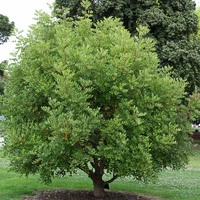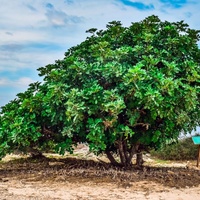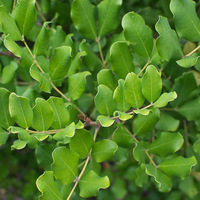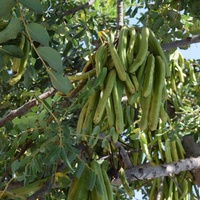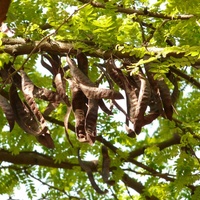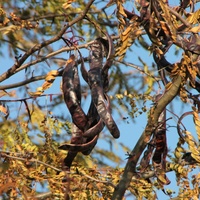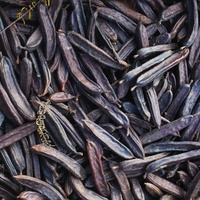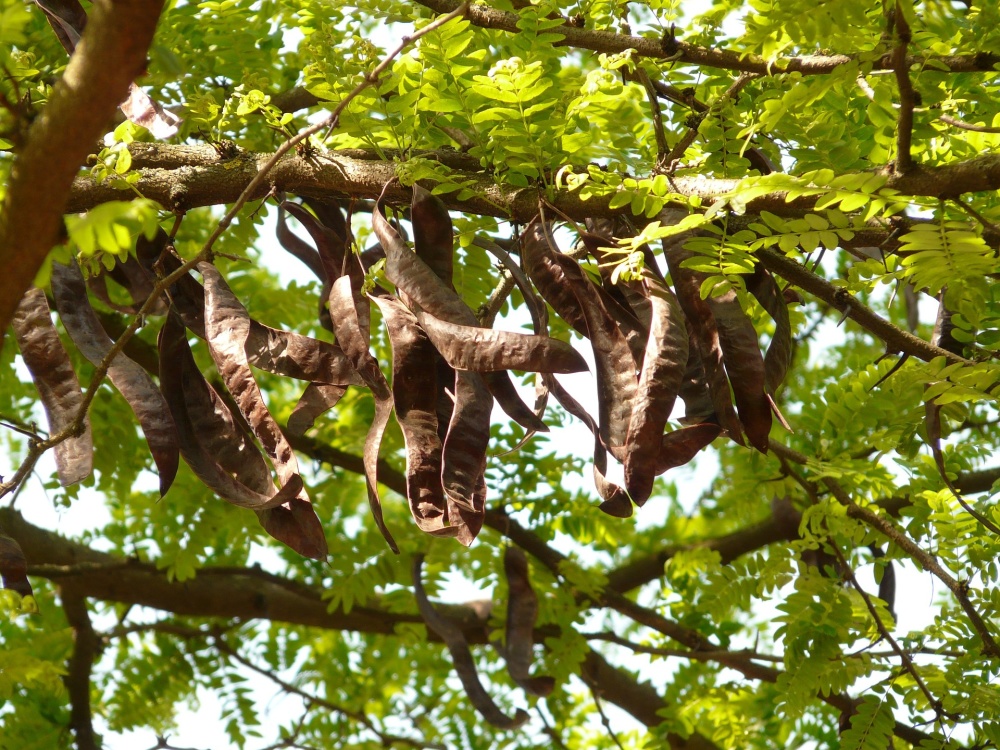Common name: Carob
Other common names: Locust Bean, St. Johns Bread
Description
Carob or Locust bean is a tree native to the Mediterranean, its natural range extending from Morocco, north to Spain and east to Cyprus, Turkey and Syria. A very useful tree, it has long been cultivated for its seedpods, which yield a natural gum used in the food, livestock feed, cosmetic and textile industries.
It is a slow-growing, small to medium-sized tree, up to a height of 20 m (65), though it is more typically 5 to 10 m (16 to 33 ft) tall with a stout trunk supporting a densely leafy, rounded crown. The bark is dark grey, thin, smooth on young trees becoming flaking with age.
Leaves are 10 to 20 cm (3 to 6 in) long and feathery, consisting of four to ten oval leaflets arranged in pairs along the length. These emerge bronze-red, become green with age and have a leathery texture. They remain on the tree throughout the year.
The flowers are small and insignificant, tubular, petal-less and either female (greenish) or male (tinted red) on separate trees, borne in tail-like clusters arising along the branches. They are followed by straight, sometimes slightly curved seedpods 10 to 30 cm (4 to 12 in) long hanging pendant from the branches. Green when young, they become dark brown when fully mature, at around twelve months after fruit-set, and have five to fifteen hard seed embedded in a sweet, light brown, jelly-like pulp.
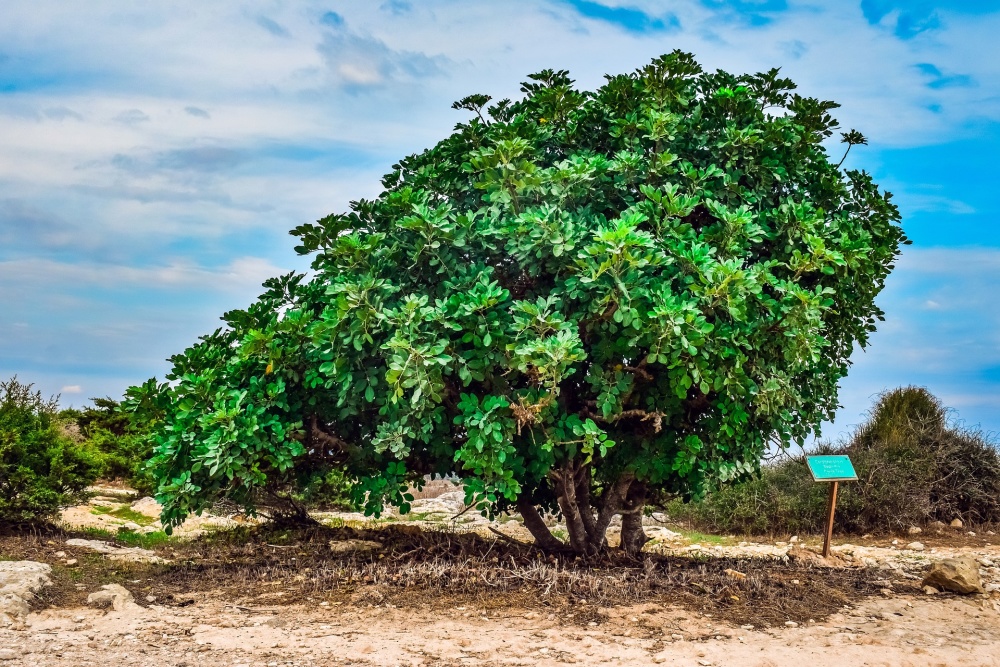
Use
The ripened seedpods are rich in sugars and used since ancient times as human food and livestock feed. In recent times, the seedpods have been transformed into a range of products derived separately from the pod-shells and seed.
The de-seeded shells are ground-up, fermented and distilled into alcohol or are converted into feed cake for cattle. They are also roasted and ground into a flour known as 'carob powder', used as a cocoa or chocolate substitute in baked confectionery and as a colouring and flavouring agent in food.
The seed are the source of 'carob gum', also known as 'locust seed gum', obtained by first grinding the seed to a powder, then dissolving the powder in hot water to produce an adhesive, transparent jelly.
Carob gum has a wide range of applications, particularly in the food, cosmetic, textile and paper industries. It has thickening, gelling, binding, moulding, clouding and flavouring properties and is used in dairy drinks and desserts, ice cream, fruit drinks, baked goods, salad dressings, mayonnaise, pie fillings, sauces, baby food, soft candy and pet food. It also has application in the textile industry, coating textiles and sizing yarn and paper manufacture to improve sheet formation and increase dry sheet strength. In cosmetics, it is used mainly as a thickener and stabiliser. Still, it is also found used in moisturisers, anti-ageing creams, sunscreens, facial masks and nail treatments.
The seed are also ground-up for cattle feed but are high in tannic acid, an antifeedant that reduces the digestibility of other feed ingredients. And it should not be fed to cattle in amounts greater than 20% of the total ration. However, when treated to remove the tannic acid, the meal is highly digestible and has a crude protein content of around 18% of its dry weight.
The flowers produce reasonable quantities of nectar and are foraged by honeybees. The pure honey is dark amber with a subtle, bittersweet flavour reminding of caramel and chocolate and quickly crystallises to a soft, coarse grain.
It produces a medium-weight wood with reddish-brown heartwood used mainly for firewood but tends to spark, so it is not recommended for open fires.
Health use
Carob powder has long been used as an anti-diarrhoeal in its native range. Its natural tannins have an astringent effect on the gastrointestinal tract, helping to relieve irritation.
Climate
Although naturally adapted to Mediterranean climates, Carob trees flower and produce good quality seedpods in dry to moderately humid subtropical and tropical savanna climates, generally areas with annual lows of 8 to 23°C, annual highs of 19 to 35°C, annual rainfall of 200 to 1300 mm and a dry season of 3 to 8 months. Carob is also cultivated with irrigation in areas where the dry season extends up to 12 months.
Growing
New plants can be started from seed, but the sex is not easily determined prior to flowering. A common practice to encourage good pollination is to graft or bud a few male branches onto an established female tree.
Performs best on free-draining loam and sand soils of a neutral to alkaline nature, generally with a pH of 7.0 to 8.0, and on sites with full to partial sun exposure. It has good tolerance to limestone soils but poor tolerance to slow-draining or waterlogged soils.
Yields from mature, rain-fed trees are reported to average 100 to 200 kgs (220 to 440 lbs) of seedpods per year.
Problem features
It is recorded as having naturalised in some countries in the Mediterranean, where it has long been introduced, and countries such as Australia, where it is recorded as having escaped cultivation and a weed of the natural environment. However, there does not appear to be any record of it anywhere as a serious weed.
Where it grows
References
Books
-
Allen, O. N. & Allen, E. K. 1981, The Leguminosae : a source book of characteristics, uses, and nodulation, University of Wisconsin Press, Madison, Wisconsin
-
Attokaran, M. 2011, Natural food flavors and colorants, Institute of Food Technologists, Wiley-Blackwell Publishing, Oxfordshire
-
Barwick, M., et al. 2004, Tropical & subtropical trees : a worldwide encyclopaedic guide, Thames and Hudson, London
-
Brady, G. S. & Clauser, H. R & Vaccari, J. A. 2002, Materials handbook : an encyclopedia for managers, technical professionals, purchasing and production managers, technicians and supervisors, 15th ed., McGraw-Hill, New York
-
Chevallier, A. 2000, Encyclopedia of herbal medicine, 2nd American ed., Dorling Kindersley, New York
-
Coppen, J. J. W. 1995, Gums, resins and latexes of plant origin, Food and Agriculture Organization of the United Nations (FAO), Rome
-
Dastur, J. F. 1964, Useful plants of India and Pakistan : a popular handbook of trees and plants of industrial, economic, and commercial utility, 2nd ed., D. B. Taraporevala Sons, Bombay
-
Gohl, B. 1981, Tropical Feeds : feed information summaries and nutritive values (Revised edition), Food and Agriculture Organization of the United Nations (FAO), Rome
-
Hall, N. 1972, The use of trees and shrubs in the dry country of Australia, Australian Government Publishing Service, Canberra, Australian Capital Territory
-
Howes, F. N. 1949, Vegetable gums and resins, Chronica Botanica Company, Waltham, Massachusetts
-
Imeson, A. 2010, Food stabilisers, thickeners and gelling agents, Wiley-Blackwell Publishing, Chichester, United Kingdom
-
Khan, I. A. & Abourashed, E. A. 2010, Leung's encyclopedia of common natural ingredients : used in food, drugs and cosmetics, 3rd edition, Wiley Publishing, Hoboken, New Jersey
-
Macmillan, H. F. 1943, Tropical planting and gardening : with special reference to Ceylon, 5th ed, Macmillan Publishing, London
-
Morton, J. F. & Dowling, C. F. 1987, Fruits of warm climates, Creative Resources Systems, Winterville, North Carolina
-
Perry, B. 2010, Landscape plants for California gardens: an illustrated reference of plants for California landscapes, Land Design Publishing, Claremont, California
-
Randall, R. P. 2002, A global compendium of weeds, R.G. and F.J. Richardson Press, Melbourne
-
Randall, R. P. 2007, The introduced flora of Australia and its weed status, Cooperative Research Centre for Australian Weed Management, Glen Osmond, South Australia
-
Sheikh M. I. 1993, Trees of Pakistan, USAID Forestry Planning and Development Project, Pictorial Printers, Islamabad
-
Standley, P. C. 1920, Trees and shrubs of Mexico, Government Printing Office (GPO), Washington D.C.
-
Webb, D. B. 1984, A Guide to species selection for tropical and sub-tropical plantations, 2nd ed., Unit of Tropical Silviculture, Commonwealth Forestry Institute, University of Oxford, Oxfordshire
-
Winter, R. 2009, A consumer's dictionary of cosmetic ingredients : complete information about the harmful and desirable ingredients found in cosmetics and cosmeceuticals, 7th ed, Three Rivers Press, New York
